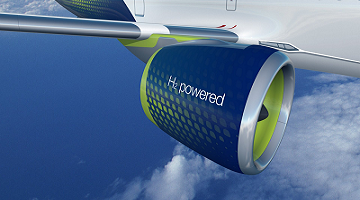
Hydrogen has a lot of promise for many applications across society, and the UK is uniquely well placed to produce and distribute a domestic hydrogen supply, as set out in the UK Government’s Hydrogen Strategy in September. ADS members, with support from the ATI, are world-leaders in the development of hydrogen as a propulsion method for aviation – and 2021 was another great year of progress on this mission.
A important role for the ATI
The Jet Zero Council is a necessary collaboration between Government, industry and academia on the road to decarbonising aviation. Innovation is a key tenet of the JZC, and none more so than through support for the Aerospace Technology Institute, or ATI. As you will see below, the work the ATI does runs throughout UK aerospace, providing the spark for the innovation and novel designs that will play a leading role as the UK aims for Jet Zero – net zero aviation by 2050. The extension of ATI funding through to 2031 was a welcome step this year, providing a runway for British innovation to continue to lead the world – but certainty in funding levels must be assured to ensure that the UK takes advantage of a thriving and first-class aerospace sector, as demonstrated by innovation in hydrogen propulsion.
Hydrogen fuel cells
After a promising 2020, ZeroAvia continue to grow and innovate towards zero emission flight, supported by the ATI, a keystone of innovation in UK aerospace. As part of the HyFlyer II programme, ZeroAvia’s conversion of a Dornier 228 into a hybrid hydrogen-electric aircraft powered by hydrogen fuel cells has attracted investment and orders all over the world, including Amazon’s Climate Pledge Fund and a recent tie up with United Airlines.
Hydrogen fuel cells, like the ones in ZeroAvia’s conversion, are similar in concept to the Toyota Mirai, a readily available hydrogen fuelled car whose only emissions are water. By combining hydrogen with oxygen from the air, a fuel cell can power an electric motor that can turn a turbine – GKN are also testing the potential of using hydrogen fuel cells in aviation through the H2GEAR programme, a collaboration between industry and academia. The opening of GKN’s Global Technology Centre in October was a milestone on GKN’s journey towards sustainable flight – and no doubt a sign of things to come
Liquid hydrogen
While hydrogen fuel cells offer a real solution, Airbus are leading the way in the development of a liquid hydrogen storage solution. The technical challenges of storing hydrogen in liquid form – which condenses at -253C – will require a rethinking of aircraft design.
This year Airbus have continued development of their ZEROe concept designs: turboprop, turbofan and blended wing designs that run on liquid hydrogen; at ADS’ pre-COP26 event in October, Airbus demonstrated a model of their blended wing concept. The research that Airbus are undertaking into safe and practical storage of liquid hydrogen will help move the needle on hydrogen flight, with a zero emission aircraft expected to be developed by 2035.
The ATI unveiled a concept aircraft in December, a product of the FlyZero programme, an ATI-led, UK Government-backed scheme to realise zero carbon flight by 2030. As ADS blogged at the time, the ATI’s concept aircraft would allow zero-emission flights non-stop on routes such as London to San Francisco.
A diverse pathway to decarbonisation
While the potential for hydrogen to decarbonise aviation is huge, hydrogen alone will not get us to net zero. A combination of Sustainable Aviation Fuels, as I blogged about last week, hydrogen, system efficiencies and market-based measures, alongside support for the ATI, will be the answer to reaching the ambitions of the Jet Zero Council – delivering zero-emission transatlantic flight within a generation.





